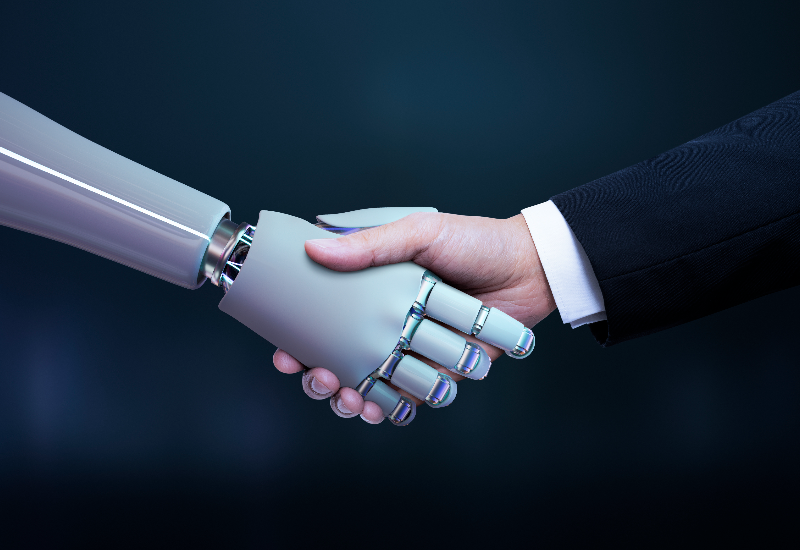In today's digital era, non-profit organizations and fundraisers have access to various innovative tools and technologies that can revolutionize how they engage with donors, maximize their fundraising efforts, and amplify their impact. One such powerful tool is Artificial Intelligence (AI). From streamlining operations to personalizing donor experiences, AI has the potential to transform the fundraising landscape.
According to the Association of Fundraising Professionals (AFP), organizations that adopt AI in their fundraising strategies experience significant improvements in key performance indicators. Their study found that non-profits leveraging AI technologies achieved an average increase of 41% in donor retention rates and a 28% increase in donation conversion rates compared to organizations not using AI.
In this blog, we will explore how you can leverage AI to elevate your fundraising efforts and provide practical tips and tricks to help you get started.
Harness the Power of Data
AI thrives on data, making collecting and analyzing donor information essential. To consolidate data, start by integrating your fundraising platforms, CRM systems, and social media channels. This unified view will enable you to gain insights into donor preferences, behavior, and giving patterns, empowering you to create personalized fundraising strategies.
What can you do?
Leverage AI-powered analytics tools to uncover valuable donor trends and segment your audience effectively. This will allow you to tailor your messaging, appeals, and fundraising campaigns to specific donor segments, increasing your chances of success.
For example, Charity: Water used AI and data analytics to optimize its fundraising campaigns. By analyzing past donor data, they identified key characteristics and behaviors of their most engaged supporters, allowing them to target similar individuals with personalized appeals. As a result, they significantly increased their donation conversion rates and overall fundraising revenue.
Personalize Donor Experiences
AI can help you deliver highly personalized experiences to your donors, fostering deeper connections and long-term engagement. By leveraging AI chatbots or virtual assistants, you can provide real-time, personalized responses to donor inquiries and support, ensuring a seamless donor journey.
How can you implement this into your work?
Implement chatbots on your website and social media platforms to handle common queries, offer donation suggestions, and provide instant responses. Use AI algorithms to understand donor interactions and preferences, allowing you to deliver customized content and recommendations that resonate with everyone.
Learn from DonorsChoose.org, an education-focused non-profit that implemented an AI-powered chatbot to enhance donor engagement. The chatbot interacted with donors, asking questions about their interests and passions, and used AI algorithms to suggest specific projects aligned with their preferences. This personalized approach led to increased donor satisfaction and higher conversion rates.
Optimize Fundraising Campaigns
AI can help you fine-tune your fundraising campaigns for maximum impact. You can predict donor behavior, identify patterns, and optimize your campaigns using real-time machine-learning algorithms. This data-driven approach allows you to allocate resources efficiently and identify the most effective strategies for reaching your fundraising goals.
How can this be useful for your organization?
Use AI algorithms to analyze historical donor data and identify key factors that drive successful campaigns. Leverage this knowledge to optimize your messaging, timing, and channels for future campaigns. Experiment with AI-powered tools that provide campaign optimization recommendations and insights based on real-time data analysis.
Once again, we will use DonorsChoose.org as an example. The organization used machine learning algorithms to analyze millions of data points from their previous campaigns. By identifying patterns and predicting donor behavior, they optimized their campaign strategies. As a result, they increased their donor engagement and achieved a record-breaking fundraising campaign, surpassing their initial goals.
Donor Prospect Identification
AI can help you identify potential major donors and build stronger relationships. By utilizing predictive analytics and AI algorithms, you can analyze vast amounts of data to identify individuals more likely to support your cause at a higher level.
What can you do in practice?
Leverage AI-powered prospect research tools that utilize wealth indicators, social network analysis, and philanthropic interests to identify potential major donors. These tools can save you time and effort by automating the prospect identification process and providing valuable insights into your prospects' capacity and inclination to give.
An example of using AI for donor prospect identification is The Michael J. Fox Foundation, which is dedicated to finding a cure for Parkinson's disease. The Foundation used AI-powered prospect research tools to identify potential major donors. By analyzing wealth indicators, connections to the cause, and philanthropic interests, they identified individuals more likely to make significant contributions. This enabled them to focus their efforts on cultivating relationships with these prospects, resulting in substantial donations that supported their research initiatives.
Enhance Donor Stewardship
AI can be vital in enhancing donor stewardship and cultivating long-term relationships. By leveraging AI algorithms, you can automate personalized communication, gratitude, and recognition efforts, ensuring that donors feel appreciated and engaged throughout their journey with your organization.
How to enhance donor stewardship using AI?
Implement AI-driven systems that automate personalized thank-you emails, acknowledgment letters, and progress updates to donors. Use AI chatbots to provide real-time updates on the impact of their contributions and answer any queries they may have. By leveraging AI, you can scale your donor stewardship efforts while maintaining an individualized touch.
Learn from UNICEF, which implemented an AI-powered system that generated personalized donor reports. These reports highlighted the specific impact of each donor's contributions, allowing them to see the tangible difference they were making. This AI-driven approach significantly increased donor satisfaction and retention rates, fostering stronger relationships with their supporters.
Fundraising Forecasting and Planning
AI can provide valuable insights for forecasting and planning your fundraising initiatives. By analyzing historical data, donor behavior, and external factors, AI algorithms can help you predict future fundraising trends, set realistic goals, and make data-driven decisions for resource allocation.
How to use AI for forecasting and planning?
Utilize AI-powered forecasting tools that can provide insights into fundraising performance and potential project revenue and identify areas of improvement. Incorporating these insights into your strategic planning allows you to optimize your fundraising efforts and allocate resources effectively.
Learn from the American Red Cross, which utilized AI-powered forecasting tools to predict blood donation patterns. By analyzing historical data, weather conditions, and community events, they could accurately anticipate demand and allocate resources accordingly, ensuring a sufficient blood supply when and where it is most needed.

What is Important Before Using AI to Improve Your Fundraising?
Set Clear Goals
Before implementing AI for fundraising, define clear goals and objectives. Determine what aim you want to achieve through AI, whether it is improving donor retention, increasing donation conversion rates, or enhancing personalization. Having well-defined goals will guide your AI implementation strategy and help measure its effectiveness.
Understand Ethical Implications
AI implementation comes with ethical considerations. Ensure you understand the potential biases, privacy concerns, and data security risks associated with AI technologies. Implement safeguards to protect donor information and ensure transparency in how AI is used to maintain trust with your supporters.
Start with Small Steps
AI implementation does not have to be an all-or-nothing approach. Identify areas within your fundraising processes where AI can bring the most value. It could be segmenting donors, personalizing communication, or optimizing campaign strategies. Start small, learn from the results, and gradually scale your AI initiatives.
Foster a Data-Driven Culture
AI relies on data, so cultivating a data-driven culture within your organization is crucial. Ensure that data is collected, stored, and analyzed effectively. Invest in data management systems, train staff members on data-driven decision-making, and effectively leverage AI tools.
Collaborate and Learn
Engage with other non-profit professionals, attend industry conferences, and join online communities to learn from their experiences with AI in fundraising. Collaboration and knowledge sharing can provide valuable insights, best practices, and lessons learned from others' journeys in implementing AI.
Embrace Continuous Learning
AI technologies evolve rapidly, so staying updated on the latest advancements and trends is essential. Follow industry blogs, join webinars, and attend training sessions to keep abreast of new developments in AI for fundraising. This ongoing learning will enable you to adapt and optimize your AI strategies over time.
Evaluate and Measure Impact
Regularly evaluate the impact of your AI initiatives on your fundraising outcomes. Monitor key performance indicators (KPIs) such as donor conversion, retention, and campaign results. Continuously analyze the data and insights provided by AI tools to identify areas for improvement and refine your strategies.
Build Internal Expertise
Develop internal expertise or consider partnering with consultants or technology providers specializing in AI for non-profits. Building a team or having external support with the necessary skills and knowledge will ensure effective implementation and maximize the value you derive from AI technologies.
Conclusion
AI offers non-profit professionals and fundraisers powerful tools to amplify their impact, streamline operations, and enhance donor engagement.
By harnessing the power of AI to harness data, personalize experiences, optimize campaigns, identify major donors, enhance stewardship, and forecast fundraising efforts, organizations can unlock new opportunities for growth and sustainability.
As technology evolves, embracing AI will become increasingly essential for non-profit success. So, seize the opportunity, explore AI-powered solutions, and unleash the full potential of your fundraising efforts in the digital age.
On the other side, never forget that AI is a tool that can enhance your efforts, but human intuition, creativity, and empathy remain vital in building and nurturing meaningful relationships with your donors.
This article is made possible by the generous support of the American people through the United States Agency for International Development (USAID). The contents are the responsibility of Catalyst Balkans and do not necessarily reflect the views of USAID or the United States Government.
The Citizen Engagement Activity in Kosovo is a five-year initiative implemented by Kosovar Civil Society Foundation (KCSF) in partnership with the United States Agency for International Development (USAID).


Leave a comment